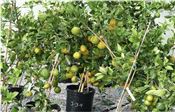Desperate times mean changes for citrus industry
Johnny Morgan
VIOLET, LOUISIANA
The number of commercial citrus growers continues to dwindle in south Louisiana, and saltwater intrusion has made growing citrus in some areas all but impossible.
For several years now, growers have been fighting what they say seems like a losing battle trying to slow the flow of saltwater — which spells death to many fruit and vegetable crops — that’s creeping in under their citrus groves.
Add to that hurricanes, insect and disease pressure, and freezing temperatures, and citrus growers are constantly in the fight to protect their crop.
A three-year LSU AgCenter study could be just what’s needed to keep the citrus industry viable in the state, said Anna Timmerman, AgCenter horticulture agent in St. Bernard and Plaquemines parishes.
The citrus production study is being conducted at the Center for Louisiana Citrus Innovation and Research at the Docville Farm in Violet. The AgCenter’s newest research center is the result of a partnership with the Arlene and Joseph Meraux Charitable Foundation.
Timmerman’s research so far shows that growing citrus indoors produces a high-quality fruit with fewer insect problems and other negative environmental issues.
Timmerman said she planted her satsumas the week before Hurricane Ida in 2021. She will be harvesting her first crop next week.
“We are looking at the pros and cons of growing citrus inside or in containers,” she said. “So far, we are finding that the pros are outnumbering cons.”
The benefits of growing indoors are lower water and fertilizer requirements, high-density planting, less root rot, no saltwater intrusion and better-quality fruit, she said.
The study will last for three years, and Timmerman is already gathering useful data that will be helpful to area growers.
Her study has the potential to influence the way that citrus is grown in that part of the state for years to come.
She said the major issue she is having right now is puffy fruit, which is edible and delicious — but the appearance is not very pleasing.
Timmerman said the citrus growers have what looks to be a good crop despite the issues they are almost constantly facing — and now is the time for consumers to enjoy the locally grown fruit.
In other parts of the growing region, the crop is also looking good this year even though some of the fruit is still green, said Barton Joffrion, AgCenter horticulture agent in Terrebonne Parish.
Joffrion said there is a common misconception about when satsumas are ready.
“Most people think the fruit has to be orange before it’s ripe and ready to eat. But that is not the case,” he said. “They actually have to be tested by the Department of Ag before they are certified ready for the market.”
Joffrion said it’s not uncommon for satsumas to still be completely green, yet sweet enough to be sold.
Citrus will not continue to ripen after it’s pulled from the tree, so people need to make sure the fruit is the desired sweetness when picked. As a rule, the earlier satsumas are picked, the less sweet they are.
Saltwater intrusion is only one of the factors affecting the number of citrus growers in south Louisiana.
The numbers have been on the decline in recent years due to farmers getting older, Joffrion said.
“The development of subdivisions on some of the best land is the reason a lot of the bigger producers are gone now,” he said. ∆

Satsuma trees planted the week before Hurricane Ida last year are yielding their first crop. Anna Timmerman,
LSU AgCenter horticulture agent in St. Bernard and Plaquemines parishes, said growing citrus in containers may be the only option for growers in areas with saltwater intrusion.
Photos by Johnny Morgan/LSU AgCenter